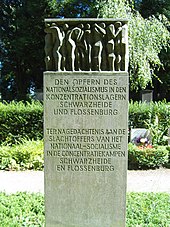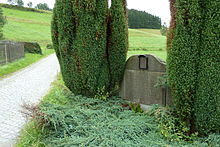Schwarzheide subcamp

The Schwarzheide subcamp was located about one kilometer northeast of the town of Schwarzheide , between Schipkauer Strasse and the A13 motorway, at the level of today's BASF Schwarzheide GmbH paint facility .
description
During the Second World War , more than 100 satellite camps of the Sachsenhausen and Ravensbrück concentration camps were set up, especially in today's federal states of Berlin, Brandenburg and Mecklenburg-Western Pomerania . From July 5, 1944 to April 16, 1945, the Schwarzheide subcamp was one of the Sachsenhausen subcamps with around ten wooden barracks in a pine grove.
BRABAG , the lignite gasoline company for the production of synthetic fuel , was located near the forced labor camp at a distance of around 100 meters . Previously used for a department of the German protection police, then as a prisoner of war camp for Italian prisoners, on July 3, 1944, around 1,000 prisoners were transferred from Auschwitz-Birkenau to do reconstruction work after the Allied bombings. Surprisingly for the prisoners, the work was suddenly stopped in April 1945 and on April 18, 1945 a death march began south towards the Bohemian town of Warnsdorf . From here they were transported back to the Theresienstadt concentration camp via various stations in freight wagons until May 7, 1945, immediately before the liberation by the Red Army . Of the former 1000 prisoners, only about two hundred survived or, according to Jakov Tsur , a former prisoner, less than a third.
Chronology of the death march
Much information about the course and about the victims of the death march has been handed down by the inmate and camp paramedic Heinrich Roeder, who forbidden noted the names of the perished prisoners in a notebook that he carried hidden in a bandage on his upper arm.
April 18, 1945
The death march begins at 5 a.m. 600 to 650 prisoners march away and have to pull a cart onto which the dead are loaded. The camp commandant SS-Hauptsturmführer Franz Sokol is in command. The luggage of the SS crew is carried in a truck.
April 19, 1945
The column reaches Kamenz . The inmates spend the night in a brick factory.
April 20, 1945
Six prisoners unable to walk are shot. The column moves further south. On the way, Soviet tanks are spotted twice in the distance. The SS people drive the prisoners to a faster pace. The prisoners spend the following night outdoors not far from Bischofswerda .
April 21, 1945
The column reached Neustadt in Saxony , where six prisoners were gunned down at the cemetery wall:
- Robert Kuffler, Alfred Weinstein, Egon Belak, Milan Mahrer, Franz König and Hans Lustig.
The inmates spend the second night outdoors.
April 22, 1945
Five prisoners who cannot get up in the morning are shot by the SS:
- Josef Trakatsch (inmate number 86090), Fritz Pollak (85857), Nowicki, a Pole (185839) and two French (118724, 114673).
The column marches on via Sebnitz and reaches Saupsdorf , where the prisoners spend the night in barns. In the evening, six prisoners are buried near the Gnauckmühle:
- Harry Braun, Josef Lichtenstein, an unknown Frenchman, Josef Ružička, Paul Polaček, Oskar Sobota
April 23, 1945
The column moves on in the morning towards Hinterhermsdorf . At the Rölligmühle junction, eight exhausted prisoners were shot by the SS on the roadside:
- Ernst Stern (86049), Josef Kohut (85632), a Pole (82990), Kurt Klauber (85600), Franz Grünfeld (85454), a French (60969), Otto Ledeč (85694) and Victor Weisel (86142).
After crossing the Bohemian border, the SS guards murdered eight prisoners in a forest meadow in the Khaatal:
- Paul Fischer (85343), a Pole named Matewsky (114137), Wilhelm Slatin (85956), a Frenchman (117805), Herbert Altschul (85180), Erwin Teichner (86070), Friedrich Kaufmann (85587) and Kurt Altschul (85878).
In the evening the train reaches Oberkreibitz (Chřibská). The prisoners spend the night in the glassworks.
April 24, 1945
On the night of April 24, 1945, twelve prisoners died as a result of the march:
- Jean Barbier (58804), Ota Bergmann (85223), Rene Gauly (58562), Adalbert Grünfeld (85453), Ota Klatscher (85399), Karel Krajsky (85654), Eugen Nestel (85800), Ota Pick (85836), Hans Schiff (85993), Leopold Schlesinger (86003), Hugo Steckler (86037) and a Russian (86572).
The five prisoners who were ordered to dig a grave for those who died in the night were also shot at the still open grave and buried there:
- Gabriel Pimentel (85842), Pavel Pick (85838), Rudolf Salzer (85941), Erich Reich (85893) and a Pole (78811).
The march continued to Warnsdorf , where they were housed in a factory for ten days.
May 5, 1945
On May 5, 1945, the prisoners were divided into a Jewish and a non-Jewish group.
The non-Jewish group marched to Langenau (Skalice), where they were liberated by the Soviet army on May 10, 1945. The Jewish group is loaded into open coal wagons at Warnsdorf train station and transported to Theresienstadt , but pushed onto a siding in Böhmisch Leipa (Česká Lípa).
May 7, 1945
After the prisoners had to spend two days in the rain in the open wagons, 17 dead were found on May 7, 1945:
- Richard Brauchbar, Franz Dusak, Israel Feldmann, Franz Fleischer, Ota Frankenbusch, Eduard Friedmann, Peter Ganz, Hans Hellman, Leo Kominik, Emanuel Lederer, Viktor Lederer, Adolf Neumann, Paul Neumann, Hans Pless, Kurt Rosenbaum, Karl Stadler and Hans Wiener .
They were first buried in a forest near the village of Sosnová , later transferred to Česká Lípa and buried on October 10, 1945 in the New Jewish Cemetery .
On the same day the train reached Litomerice (Litoměřice) from where the remaining 252 Jewish prisoners were set on foot in the direction of Theresienstadt in March. Eight prisoners died on the march:
- Fritz Fantel, Rudolf Feith, Karl Fuchs, Rene Lustig, Kurt Reach, Hans Salz, Josef Stein and Franz Zunterstein.
On the night of May 8, 1945, the SS guards withdrew.
May 8, 1945
The train of Jewish prisoners reached the liberated but overcrowded Theresienstadt on its own.
literature
- Thomas Irmer: Forced labor of Jewish concentration camp prisoners in armaments production in the Berlin-Brandenburg region in the final phase of World War II - the Glöwen and Schwarzheide subcamps of the Sachsenhausen concentration camp. In: Winfried Meyer, Klaus Neitmann (Ed.): Forced labor during the Nazi era in Berlin and Brandenburg. Forms, function and reception. Verlag für Berlin and Brandenburg, Potsdam 2001, ISBN 3-932981-31-6 , pp. 163–175 ( Library of Brandenburg and Prussian History 7).
- Schwarzheide. In: Wolfgang Benz , Barbara Distel (eds.): The place of terror . History of the National Socialist Concentration Camps. Volume 3: Sachsenhausen, Buchenwald. CH Beck, Munich 2006, ISBN 3-406-52963-1 , pp. 268-271.
- Schwarzheide. In: Geoffrey P. Megargee (Ed.): Encyclopedia of Camps and Ghettos 1933–1945. Indiana University Press, Bloomington IN et al. 2009, ISBN 978-0-253-35328-3 .
Web links
Individual evidence
- ^ Compare Alfred Kantor : The Book of Alfred Kantor. New York 1971.
- ↑ Tsur (* 1925 in Ostrau as Kurt Cierer ) was transported together with 1,000 other Czech Jews from Auschwitz-Birkenau to the Schwarzheide satellite camp in July 1944 and emigrated to Palestine after the liberation. He later took part in the War of Independence and worked as a teacher in a kibbutz in Israel until his retirement .
- ↑ Heinz Senenko et al. a .: Torn from the silence. Conference report of the Young Historians working group on their results on the death march. Sebnitz 1980.
- ↑ Heinz Senenko et al. a .: Don't let the embers go out. Sebnitz 1984.
- ↑ Heinz Pulda: The outer Schwarzheide camp of Sachsenhausen concentration camp. Schwarzheide 1984.
Coordinates: 51 ° 29 '8.9 " N , 13 ° 53' 5.3" E


